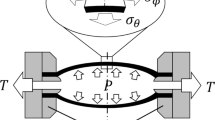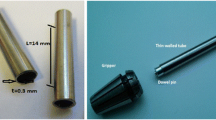Abstract
An apparatus for multiaxial loading of microtubes with an outside diameter of less than a few millimeters is described. The apparatus is capable of applying axial-force and internal-pressure in a fully-coupled way, so that biaxial principal stresses along either proportional or non-proportional loading paths can be applied to the microtubes. The requirements of the apparatus for this fully-coupled loading and the resulting functional layout are described first. The hardware that was selected is then detailed. The maximum force and pressure capacities are 2000 N and 1034 bar, while the maximum available stroke and pressurized fluid volume are 50 mm and 68 ml, respectively. Since the apparatus is required to perform dynamic loading as well, with the stresses varying on the order of 1 Hz, the dynamic behavior of the pump used in the apparatus is established experimentally. It was determined that the dynamic response depends not only on the amplitude and frequency of the desired loading, but also, partially because of the minute dimensions of the apparatus, on the volume of fluid in the system and the compressibility of the fluid used for the inflation. The capabilities of the apparatus are demonstrated by proportional and non-proportional biaxial experiments on 304L stainless steel microtubes of 2.38 mm outside diameter and 0.15 mm nominal thickness. Two different strategies for performing these experiments, i.e., force- & volume-control and displacement- & pressure-control were implemented and are compared to each other. The former leads to a more stable system and thus is the preferred mode of operation of the apparatus, while the latter can allow better tracking of the microtube response past the observed limit-load instability. In the proportional loading experiments, the nominal stress paths are shown to be exactly linear, as desired. Although not pursued here, such experiments can be used to establish the plastic anisotropy of the microtube material. Two types of non-proportional experiments are performed: in both cases the microtube is loaded uniaxially (axial or hoop direction); then, by keeping that stress constant, the other principal stress (i.e., hoop or axial) is increased until failure. Digital Image Correlation is used to measure the full strain fields during the testing, establishing the strains at the limit of uniform deformation. Furthermore, comparison of the strain paths induced during the proportional and non-proportional experiments established the path-dependency of the failure strains. These successful experiments demonstrate that any complex loading path inside (or adjacent to) the first quadrant of the plane-stress space can be implemented with this apparatus.



















Similar content being viewed by others
References
Kuwabara T (2014) Biaxial stress testing methods for sheet metals. In Comprehensive Materials Processing; van Tyne CJ (ed) Elsevier Ltd., Vol. 1, pp 95–111
Nadai A (1950) Theory of flow and fracture of solids, vol 1. McGraw-Hill, Ney York
Hecker SS (1975) Experimental studies of yield phenomena in biaxially loaded metals. In: Stricklin JA, Saczalski KL (eds.) Constitutive equations in viscoplasticity: computational and engineering aspects, Vol. 20 ASME AMD (1975), pp. 1–33
Michino MJ, Findley WN (1976) A historical perspective of yield surface investigation for metals. Int J Non Linear Mech 11(1):59–82
Phillips A (1974) Experimental plasticity – some thoughts on its present status and possible future trends, Problems of plasticity. Noordhoff International Publishing, Leiden, pp 193–231
Phillips A (1986) A review of quasistatic experimental plasticity and viscoplasticity. Int J Plast 2(4):315–328
Szczepiński W (1990) Experimental methods in mechanics of solids (Vol. 51). Elsevier Science Ltd
Guest JJ (1900) V: on the strength of ductile materials under combined stress. Philos Mag 50(302):69–132
Lode W (1926) Versuche über den einfluss der mittleren hauptspannung auf das fliessen der metalle eisen, kupfer und nickel. Z Phys 36(11–12):913–939
Davies EA (1943) Increase of stress with permanent strain and stress‐strain relations in the plastic state for copper under combined stresses. ASME J Appl Mech 10:A187–A196
Davies EA (1945) Yielding and fracture of medium-carbon steel under combined stress. ASME J Appl Mech 12(1):A13–A24
Hecker SS, Strait BG, Lang RM (1970) Apparatus for plasticity experiments under biaxial stresses (No. LA--4550). Los Alamos Scientific Lab., NM
Hecker SS (1971) Yield surfaces in prestrained aluminum and copper. Metall Met’l Trans B 2(8):2077–2086
Stout MG, Hecker SS, Bourcier R (1983) An evaluation of anisotropic effective stress–strain criteria for the biaxial yield and flow of 2024 aluminum tubes. ASME J Eng Mat’l Technol 105(4):242–249
Stout MG, Hecker SS (1983) Role of geometry in plastic instability and fracture of tubes and sheet. Mech Mater 2(1):23–31
Korkolis YP, Kyriakides S (2008) Inflation and burst of anisotropic aluminum tubes for hydroforming applications. Int J Plast 24(3):509–543
Hill R, Hecker SS, Stout MG (1994) An investigation of plastic flow and differential work hardening in orthotropic brass tubes under fluid pressure and axial load. Int J Solids Struct 21:2999–3021
Hill R, Hutchinson JW (1992) Differential hardening in sheet metal under biaxial loading: a theoretical framework. ASME J Appl Mech 59:1–9
Kyriakides S, Yeh MK (1988) Plastic anisotropy of drawn metal tubes. ASME J Eng Ind 110:303–307
Yoshida K, Kuwabara T (2007) Effect of strain hardening behavior on forming limit stresses of steel tube subjected to nonproportional loading paths. Int J Plast 23(7):1260–1284
Kuwabara T, Sugawara F (2013) Multiaxial tube expansion test method for measurement of sheet metal deformation behavior under biaxial tension for a large strain range. Int J Plast 45:103–118
Ripley PW, Korkolis YP (2014) Necking instabilities of pressurized thin-walled microtubes under tension. ASME Int’l Mech Eng Conf Expo IMECE, Montreal, Nov 14–20
Lasebikan BA, Akisanya AR (2014) Burst pressure of super duplex stainless steel pipes subject to combined axial tension, internal pressure and elevated temperature. Int J Press Vessel Pip 119:62–68
Kuwabara T, Yoshida K, Narihara K, Takarhashi S (2005) Anisotropic plastic deformation of extruded aluminum alloy tube under axial forces and internal pressure. Int J Plast 21:101–117
Korkolis YP, Kyriakides S (2008) Inflation and burst of aluminum tubes. Part II: an advanced yield function including deformation-induced anisotropy. Int J Plast 24(9):1625–1637
Korkolis YP, Kyriakides S (2009) Path-dependent failure of inflated aluminum tubes. Int J Plast 25:2059–2080
Korkolis YP, Kyriakides S, Giagmouris T, Lee L-H (2010) Constitutive modeling and rupture predictions of Al-6061-T6 tubes under biaxial loading paths. ASME J Appl Mech 77:064501-1/-5
Yoshida K, Ishii A, Tadano Y (2014) Work-hardening behavior of polycrystalline aluminum alloy under multiaxial stress paths. Int J Plast 53:17–39
Tomlinson P, Azizi-Alizamini H, Poole WJ, Sinclair CW, Gharghouri MA (2013) Biaxial deformation of the magnesium alloy AZ80. Metall Mater Trans A 44(7):2970–2983
Davies RW, Khaleel MA, Kinsel WC, Zbib HM (2002) Anisotropic yield locus evolution during cold pilgering of titanium alloy tubing. ASME J Eng Mat’l Technol 124(2):125–134
Khan AS, Kazmi R, Pandey A, Stoughton T (2009) Evolution of subsequent yield surfaces and elastic constants with finite plastic deformation. Part I: a very low work hardening aluminum alloy (Al6061-T6511). Int J Plast 25(9):1611–1625
Khan AS, Pandey A, Stoughton T (2010) Evolution of subsequent yield surfaces and elastic constants with finite plastic deformation. Part II: a very high work hardening aluminum alloy (annealed 1100 Al). Int J Plast 26(10):1421–1431
Khan AS, Pandey A, Stoughton T (2010) Evolution of subsequent yield surfaces and elastic constants with finite plastic deformation. Part III: yield surface in tension–tension stress space (Al 6061–T 6511 and annealed 1100 Al). Int J Plast 26(10):1432–1441
Geiger M, Kleiner M, Eckstein R, Tiesler N, Engel U (2001) Microforming. CIRP Ann 50:445–462
Engel U, Eckstein R (2002) Microforming-from basic research to its realization. J Mater Proc Tech 125–126:35–44
Vollertsen F, Biermann D, Hansen, Jawahir IS, Kuzman K (2009) Size effects in manufacturing of metallic components. CIRP Ann 58:566–587
Sutton MA, Orteu J-J, Schreier HW (2009) Image correlation for shape, motion and deformation measurements: basic concepts, theory and applications. Springer, New York, NY
Cullen GW, Korkolis YP (2013) Ductility of 304 stainless steel under pulsed loading. Int J Solids Struct 50:1621–1633
Anon (2008) Material data sheet: EOS stainless steel PH1 for EOSINT M 270
Ripley PW (2014) Biaxial stress testing of SS-304L microtubes by axial load and internal pressure. MS Thesis, Univ. New Hampshire
Mori K, Maeno T, Maki S (2007) Mechanism of improvement of formability in pulsating hydroforming of tubes. Int J Mach Tools Manuf 47:978–984
George HF, Barber A (2007) What is bulk modulus and when is it important? Hydraul. & Pneum. Aug. 9 issue
Hosford WF, Caddell RM (2007) Metal forming: mechanics and metallurgy. Cambridge Univ. Press, New York, NY
Acknowledgments
This work was performed under the CAREER grant CMMI-1150523 from the National Science Foundation, whose support is acknowledged with thanks. The help of Charles Spellman of Psylotech, Inc., was instrumental in developing the controller of the described apparatus. We thank Scott Campbell for his expert help in machining the custom components of this apparatus, Sheldon Parent for technical assistance and Paul Knysh for helping with the preparation of the manuscript.
Author information
Authors and Affiliations
Corresponding author
Rights and permissions
About this article
Cite this article
Ripley, P.W., Korkolis, Y.P. Multiaxial Deformation Apparatus for Testing of Microtubes Under Combined Axial-Force and Internal-Pressure. Exp Mech 56, 273–286 (2016). https://doi.org/10.1007/s11340-015-0097-y
Received:
Accepted:
Published:
Issue Date:
DOI: https://doi.org/10.1007/s11340-015-0097-y




